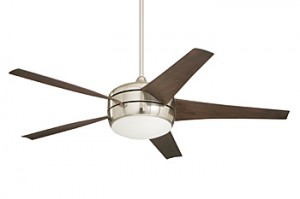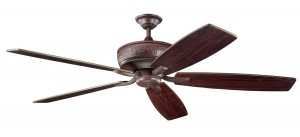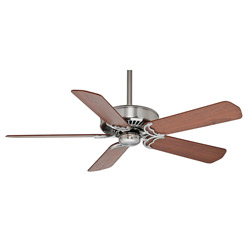If you’ve been shopping lately for ceiling fans, you may have noticed more and more options available featuring DC, or direct current, motors. With much buzz in the residential lighting industry surrounding LED, it’s easy to overlook these technological marvels that can also make a significant impact on energy savings in today’s homes. Here’s why.

The Midway Eco ceiling fan by Emerson Fans was one of the first DC ceiling fans on the market and is still one of the most energy efficient fans to be found, with an impressive 355 cfm/w.
If you’ve lived in Texas long, you may already be convinced that ceiling fans are a must for every room in your home. All ceiling fans can help lower your electricity bills by making a room feel up to seven degrees cooler just from the cooling sensation of air blowing on the skin, allowing homeowners to set their thermostats several degrees higher while still achieving the same perceived comfort.
But ceiling fans featuring DC motors achieve this same goal while running on a fraction of the electricity used by traditional AC motors. When comparing the efficiency of ceiling fans, the key metric to look at is airflow efficiency, which is measured in cubic feet per minute per watt (cfm/w). This sounds like a mouthful, but essentially it means the amount of air a fan can move in one minute using one watt of electricity. This metric gives a uniform standard to measure efficiency of all ceiling fans regardless of their size, blade pitch or other attributes.
Let’s take a look at the Panama ceiling fan from Casablanca Fan Company to compare. The original model featuring an AC motor uses 106 watts and has an airflow efficiency of about 50 cfm/w. The Energy STAR version of this same fan, which also features an AC motor, uses 76 watts and moves about 79 cfm/w. However, the DC motor version of this fan, released earlier this year, moves a mind boggling 235 cfm/w while consuming only 29.5 watts! That’s almost five times more efficient than the original model!
You may be thinking that DC motors are not a new technology, and you’d be right. Only in the last few years, however, have they become technologically sophisticated enough to be adapted for use in residential ceiling fans. DC motors, at their simplest, use permanent, built-in magnets to attract and repel a rotor around an axis. DC ceiling fans use a newer type of “brushless” DC motor that are even more efficient and are whisper-quiet, but they require more advanced electronics to control the speed.

The Monarch DC ceiling fan by Kichler Lighting creates a focal point for any large room with it's oversized 70 inch blade span.
So how does this affect your bottom line? As with most energy saving products, you’ll spend a little more up front on these highly efficient marvels, but across the lifetime of the fan, you’ll come out ahead. Add that to the savings from setting the thermostat a couple degrees higher, and DC motor fans could help make a nice dent in your energy costs on an annual basis.
